Travel guide highlights Oregon tribes
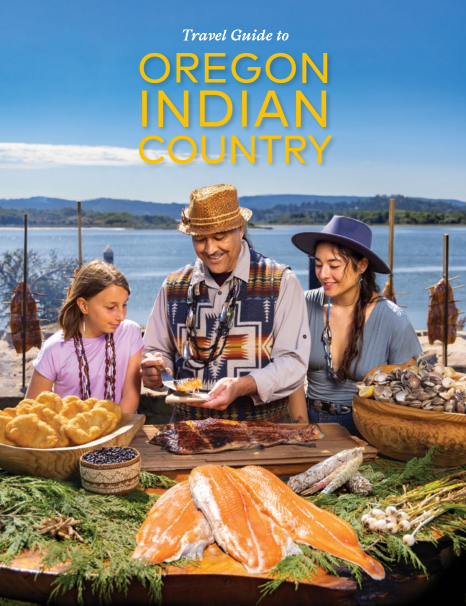
Dr. Jason Younker, chief of the Coquille Indian Tribe, and tribal members Matilda ViksneHill (left) and Kiana Younker appear on the travel guide’s cover.
See the story in Portland Monthly

Dr. Jason Younker, chief of the Coquille Indian Tribe, and tribal members Matilda ViksneHill (left) and Kiana Younker appear on the travel guide’s cover.
See the story in Portland Monthly
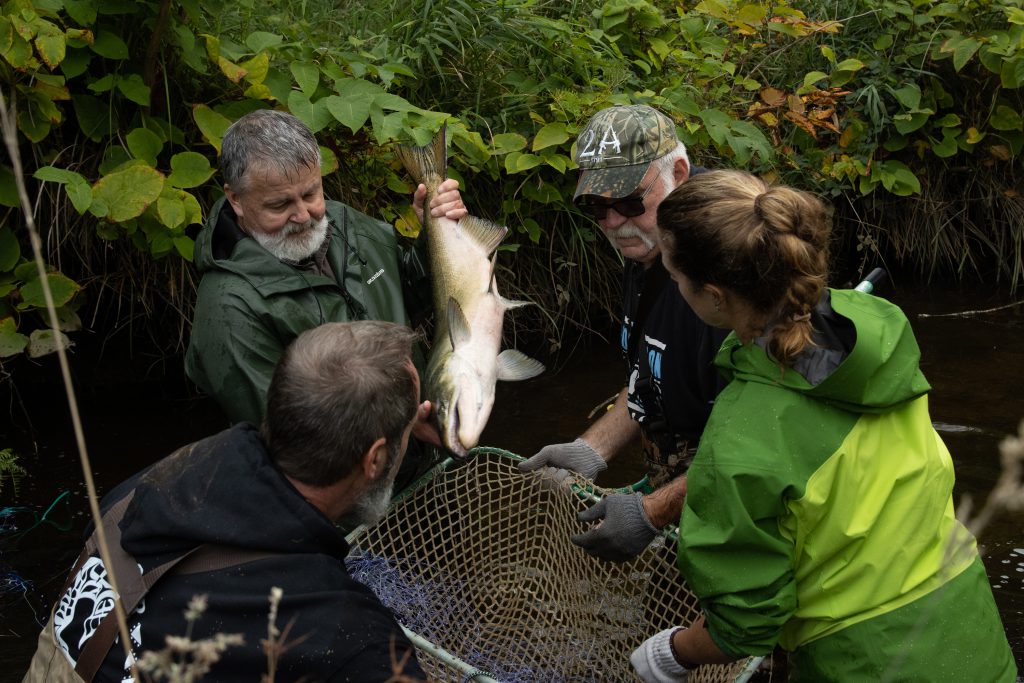
David Welch, manager of the Bandon Hatchery, lifts an adult salmon from the waters of Ferry Creek, with help from Coquille Tribal employees and a STEP volunteer. The fish was transferred to a truck-mounted tank for transport to the hatchery.
Oct. 14, 2022
BANDON, Ore. – Chinook salmon numbers are stronger on the Coquille River this fall, thanks to improved ocean conditions and cooperative work by multiple agencies and local volunteers.
“The Pacific Ocean is bringing our fish back this year, and we’re all so happy and thankful for that,” said John Ogan, head of the Coquille Indian Tribe’s Natural Resources Office.
This year the tribe negotiated a cooperative management agreement with the Oregon Department of Fish and Wildlife, and the two agencies are jointly leading efforts to capture adult salmon as they return to Bandon’s Ferry Creek. As of mid-October, they had netted 36 adult females and 39 adult males.
Those fish will become brood stock at the Bandon Hatchery. The number already exceeds the 24 breeding pairs collected on Ferry Creek last fall, and the season has barely begun. Many salmon are believed to be waiting for heavier flows before starting their upstream trek.
“We all believe that the first rain we get, that’s going to be fun,” Ogan said. “They’ll get that freshet smell, and it’s game on.”
In addition to the ocean’s improved productivity, humans have taken steps to help salmon feel welcome at Ferry Creek. With financial help from the Port of Bandon, volunteers have installed a V-shaped fence that funnels fish through a narrow passage and blocks their return. Other improvements include a new fish trap and “jump pools” that function like a fish ladder to lead fish upstream.
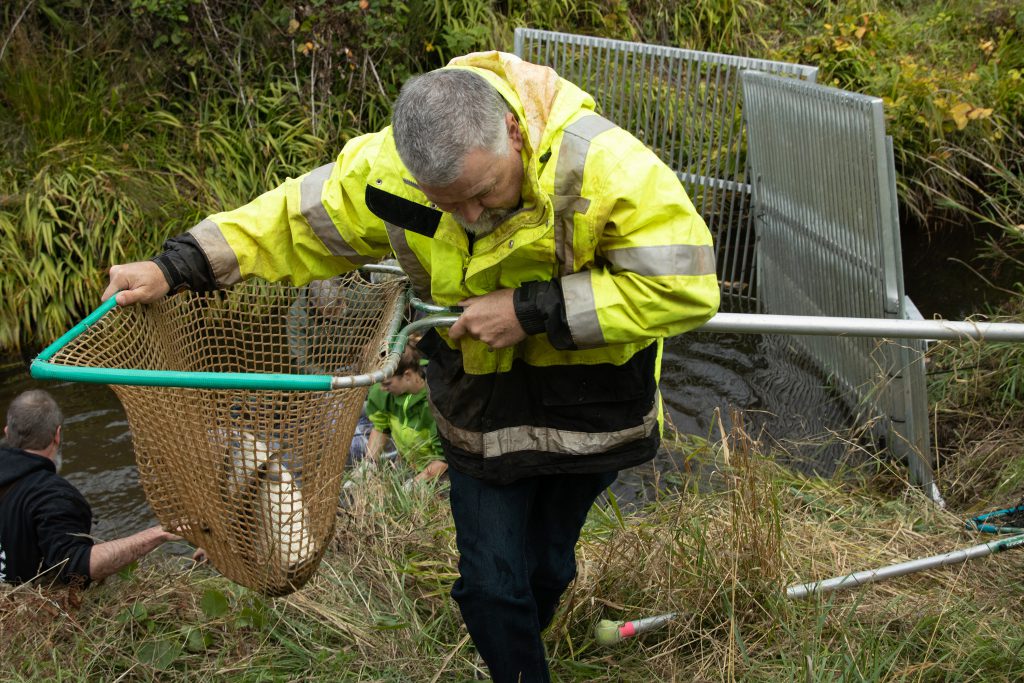
Mark Johnston, executive director of the Coquille Indian Tribe, pitches in to carry a salmon to a waiting tank truck.
Ogan praised the work of community volunteers from the Coquille Salmon and Trout Enhancement Program.
“A special tip of the hat to the STEP group,” he said. “They had the boots on the ground and the chest waders in the stream, and they did a lot of work.”
Ogan hopes the partner agencies will collect at least 50 to 60 breeding pairs for spawning at the Bandon Hatchery. The goal is to release at least 155,000 baby salmon, known as smolts, into the Coquille River system – and if even more if a bountiful brood allows.
This is the Coquille Tribe’s second year of partnering with ODFW and the local community to restore fall Chinook. Last year the tribe declared an emergency after learning that Chinook numbers had plummeted.
Producing salmon eggs for hatchery production is just one phase of the project. This summer the Oregon Fish and Wildlife Commission approved a “conservation hatchery” program on the Coquille River.
Aug. 1, 2022
A formidable new weapon is coming to defend the Coquille River’s salmon.
An electrofishing boat, paid for with a $100,000 grant from the Spirt Mountain Community fund, will help the Coquille Indian Tribe target invasive bass that prey on juvenile salmon.
“This is another great example of community partners coming together,” said Coquille Tribal Chairman Brenda Meade.
The Spirit Mountain fund is the grant-making arm of the Confederated Tribes of Grand Ronde. The $100,000 is a tangible example of Oregon tribes working together for the welfare of tribal members and the broader society.
After learning last year that fall Chinook salmon had become perilously scarce on the Coquille River, the Coquille Tribe announced an ambitious plan to rescue and restore the cherished fish. Zapping and netting predatory bass is one of several tactics the tribe has employed.
So far, the tribe has used an electrofishing boat on loan from the Oregon Department of Fish and Wildlife. Once the new boat is outfitted and launched, the tribe and ODFW can double-team the unwelcome invaders.
The tribe and ODFW recently signed a co-management agreement, creating a partnership to protect salmon and other natural resources in the Coquille River watershed.
Aug. 1, 2022
NORTH BEND – The Coquille Indian Tribe expressed gratitude today to Oregon’s U.S. senators for supporting the tribe’s conservation efforts on its namesake river.
The Senate’s appropriation bills for 2023 include $750,000 for Coquille River salmon conservation, according to Sens. Ron Wyden and Jeff Merkley.
“This is going to help us address watershed management in a holistic manner,” said Tribal Chairman Brenda Meade.
After learning last year that the Coquille River’s fall Chinook salmon run was in peril, the tribe launched a cooperative initiative to rescue and restore the prized fish. Initial efforts, aided by a coalition of community partners, grew into a historic agreement for the tribe and the Oregon Department of Fish and Wildlife to co-manage the Coquille watershed.
Salmon restoration remains a priority, but Meade said cooperative efforts for habitat restoration will benefit a wide range of struggling species, including coho salmon and lamprey.
“We’ll continue looking for more resources and working with our community partners,” she said. “The work has just begun.”
The Senate appropriation bills are not final. They need to be merged with the House’s version of 2023 appropriations.
More details about the bills can be found in Merkley’s July 29 press release.
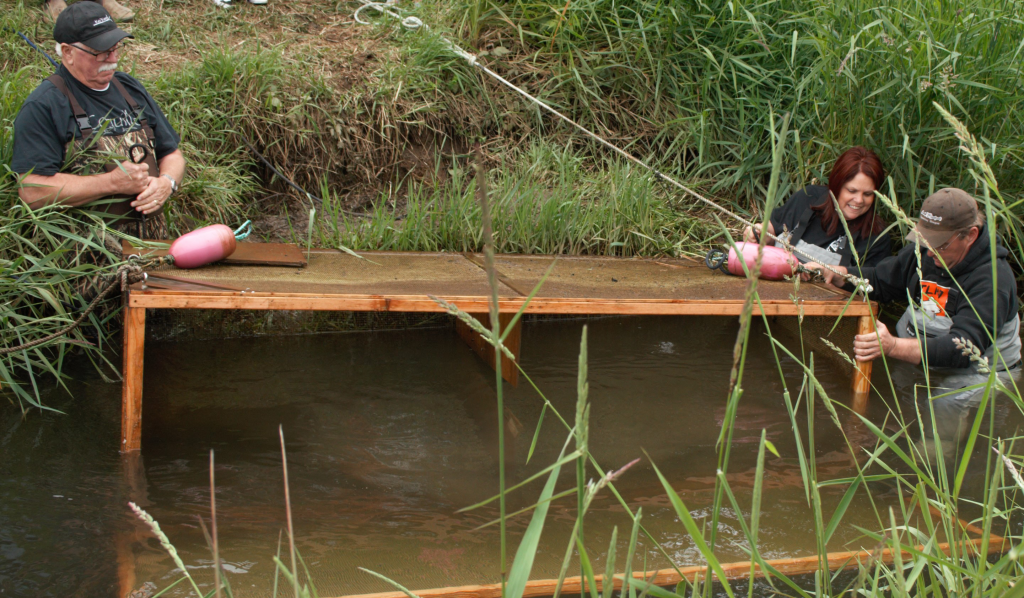
Tribal Council member Don Garrett, Chairman Brenda Meade and Health Hampel, president of the Coquille River STEP volunteers, open an acclimation box to free 1,000 juvenile salmon in Lampa Creek near Bandon.
BANDON, Ore. – A thousand tiny fish made a little history this week.
The first batch of juvenile Chinook salmon from the Coquille Indian Tribe’s 2021 spawning project swam from a mesh-covered acclimation box on Wednesday to begin their life cycle.
“This is the first of many more generations of fish that will go into their native system from Coquille Tribal lands,” said Brenda Meade, the tribe’s chairman.
The tribe plunged into the salmon project last year, after learning that the fall Chinook run in the tribe’s namesake river was nearing extinction.
“Our river is in bad shape for a lot of reasons, and we’ve got a lot of work to do,” Meade said.
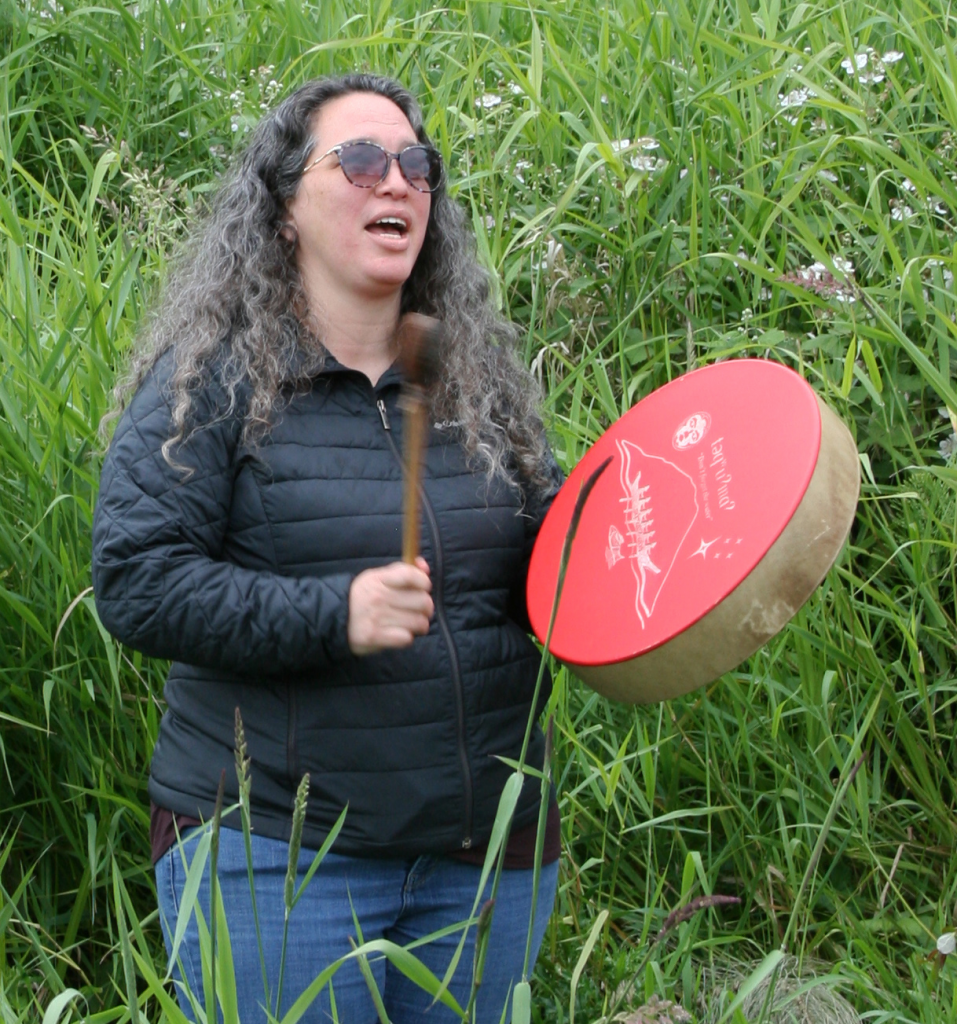
Coquille Tribal member Anne Niblett blesses the salmon with song about shady trees and cool water.
The fish that were freed this week came from eggs produced in a cooperative effort among the tribe, the Oregon Department of Fish and Wildlife, and a host of community partners and volunteers. Some of those volunteers were present Wednesday, along with tribal families and tribal staff. Joy and hope marked the event.
“It means a lot,” said Josh Bettesworth, a Salmon and Trout Enhancement Program volunteer, who helped feed the baby fish for the past few weeks. “It’s a beginning, and I think that at some point we’re going to look back on all this and say that’s where it all started.”
Bettesworth praised the tribe for its work on the river’s behalf.
“They were able to get results,” he said. “Where we all failed before is, we weren’t able to get everyone together. We weren’t able to get the port, and the city, and ODFW, and local fishing groups, and the STEP groups all together. They were able to bring that whole group together as an entirety.”
“I’m happy they’re leading the charge,” he said.
Meade thanked the tribe’s many community partners in return.
“There is no way we could have done it on our own,” she said.
The first 1,000 “pre-smolts” are the vanguard of thousands more that will be released this year by ODFW and the tribe. The little fish will head downstream to a seagoing adulthood. The hardiest among them will return to spawn in the Coquille River system.
“They’re on their journey, and I hope they have a safe trip and they come back to see us,” said Don Garrett, a member of the Coquille Tribal Council.
The salmon began their trip at Lampa Creek, about seven miles east of Bandon, on property that the tribe recently bought from Coos County.
“I’m happy for us to have that opportunity to own this property and start reintroducing salmon into this river, which is part of our culture,” Garrett said. “It’s been part of my family values throughout my whole life.”
Meade looks forward to a time when local residents can resume fishing for Coquille River salmon.
“We can’t be the generation that lets this go,” she said.
The proclamation of Indigenous Peoples’ Day is a step toward healing, one Coquille Tribal member says.
Coquille Tribal Chief Jason Younker and tribal Vice Chair Jon Ivy participated in Indigenous Peoples’ Day activities at the University of Oregon.
The Coquille Tribe put on a traditional salmon bake as part of the Oregon Wine Experience fundraiser for the Asanta Foundation and Children’s Miracle Network in Medford.
Coquille Indian Tribe members have their first subsistence hunting opportunities in five southwest Oregon counties under a new state agreement.